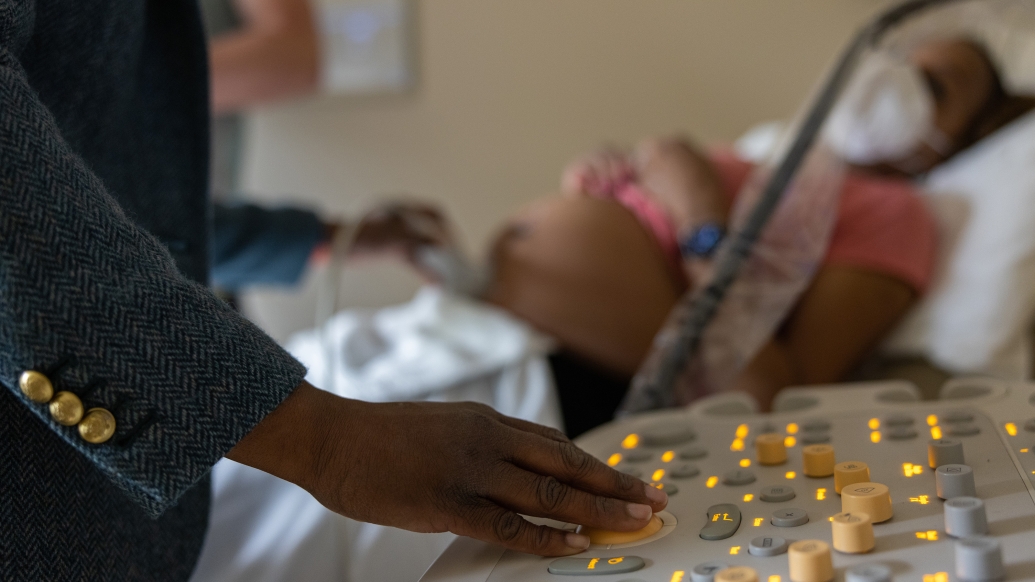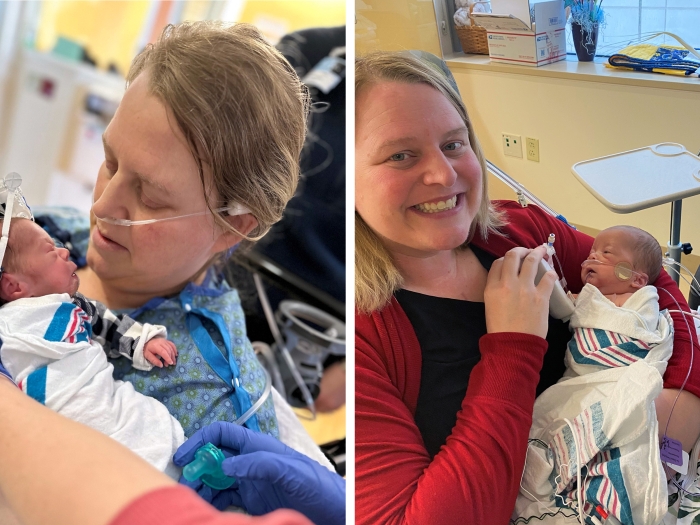A maternal-fetal medicine specialist describes the condition, its implications for women’s health and treatment available
10:40 AM
Author |

About 1 in 500 pregnancies in the United States result in placenta accreta spectrum, a range of disorders that occur when the placenta is abnormally adhered to the uterus, instead of having a normal detachment after birth.
It’s one of the most dangerous pregnancy complications and typically requires delivery at 34 or 35 weeks gestation.
This is why detection during pregnancy—with care at a level 3 or 4 maternal care center, ideally with a specialized care team—is paramount to a birthing patient’s safety.
The standard treatment for placenta accreta spectrum is a hysterectomy at the time of delivery, so the vast majority of patients with this condition will be unable to have future children.
Here, Jourdan Triebwasser, M.D., medical director of the University of Michigan Health Von Voigtlander Women's Hospital Birth Center and a maternal-fetal medicine specialist with a particular interest in this condition, shares more about detecting and treating the condition, and the importance of multidisciplinary collaboration in maternal-fetal outcomes.
What is placenta accreta?
Triebwasser: Placenta accreta spectrum is a range of conditions where the placenta is abnormally adhered to the uterus, instead of having a normal detachment after birth.
Recent estimates put it close to 1 in 500 births. Historically, it was much less common.
It’s becoming more common in the United States at least because of an increase is cesarean delivery rates, which have been high for a couple of decades.
The biggest risk factor for placenta accreta is a prior c-section.
How dangerous is placenta accreta?
Triebwasser: Placenta accreta is one of the most acute dangerous conditions at time of delivery that we manage in obstetrics.
If the placenta bleeds during delivery, there can be a massive hemorrhage.
The average blood loss is about three liters.
Most people need a transfusion, and many people need intensive care.
The primary management strategy for PAS is detection during pregnancy so a cesarean hysterectomy can be performed before labor and bleeding occur.
A cesarean hysterectomy is performed to deliver the baby safely and to prevent massive hemorrhage.
People who have a cesarean hysterectomy are not able to carry future pregnancies.
In some cases, there can be what is called a focal accreta where the abnormal attachment only occurs in a small portion of the placenta.
With a focal accreta, we may be able to remove the placenta and control the bleeding without hysterectomy.
In these situations, patients retain their uterus and can carry future pregnancies, but their risk of a future placenta accreta is increased significantly.
During pregnancy with this condition, the biggest risk for maternal health is unexpected bleeding that can lead to emergency surgery.
Trained teams have strict precautions for these patients around coming in to be evaluated during pregnancy—any bleeding or significant abdominal pain means they need to come in because they may need to be hospitalized and delivery with a cesarean hysterectomy may need to be performed at a center with a team capable of managing these complex cases.
Another piece that affects both antepartum and postpartum care is the trauma of going through a complicated pregnancy and the anticipation for most of these families that they will not be able to carry future pregnancies.
Patients with placenta accreta and their families need a lot of support adjusting to this and facing the grief that can be associated with this condition.
Peer support groups and therapists if needed, as a significant portion of patients will have post-traumatic stress disorder after having placenta accreta.
What are the risk factors of placenta accreta? How do health care providers identify and assess risks during prenatal care?
Triebwasser: Two main risk factors increase the chance of having placenta accreta: one is having a prior cesarean delivery and the second is having a placenta previa (where the placenta has implanted at the bottom of the uterus and is partially or completely covering the cervix).
Having higher numbers of prior cesarean deliveries also increases the risk.
There are other less common risk factors like in vitro fertilization, advanced maternal age, prior myomectomies (surgery to remove uterine fibroids), dilation and curettages and endometrial ablation.
These are less powerful risk factors than a prior cesarean delivery.
Identifying placenta accreta during pregnancy is critically important so that care can be directed to a level 3 or 4 maternal care center.
Those hospitals have obstetrics and supportive services including maternal-fetal medicine, anesthesiologists with specialization in obstetrics and critical care, a blood bank where you can get large volumes of blood, surgical specialists including trauma and pelvic surgeons, and intensive care/critical care.
Multidisciplinary teams at these centers can make these highly complex surgeries and the post-surgical care safer for the patient.
What diagnostic tools and techniques are most effective in identifying placenta accreta, and how early in pregnancy can it be diagnosed?
Triebwasser: Placenta accreta is typically detected antenatally, or during pregnancy, using ultrasound.
Maternal care centers with experience with ultrasound are able to detect 90% or more of placenta accreta cases.
Centers that see fewer cases may not be able to identify it quite as readily, so MRI may be used as an adjunctive imaging exam.
It’s unclear if this improves detection, and it may give a false impression that there's not a detection of PAS when in fact there is.
Identification can occur as early as the first trimester if a pregnancy happens to implant in a prior cesarean scar, known as a cesarean scar ectopic pregnancy, which is rare.
These cases are detected in the first trimester because the pregnancy will look different than a normal first-trimester pregnancy due to the amniotic sac being outside of the normal endometrial lining.
You can see it in the scar in front of the uterus.
If a patient with this condition opts to continue the pregnancy, we counsel them that they have a very high chance of placenta accreta.
Most placenta accreta cases are diagnosed in the second or third trimester with ultrasound exams done for other reasons like a 20-week anatomy scan or to confirm or monitor placenta previa.
What are the benefits of detecting placenta accreta early?
Triebwasser: The biggest benefit of early detection is that people who may get their obstetric care in a level 1 or level 2 hospital center that typically cannot manage this condition may have time for a referral and consultation for birth planning at a center like Von Voigtlander Women’s Hospital.
Earlier in the pregnancy is better so patients have time to meet all the teams involved in their care.
It’s also helpful to begin care at a level 3 or 4 hospital center should the patient encounter bleeding or other issues during the pregnancy.
How does placenta accreta impact a baby during pregnancy? Can there be complications?
Triebwasser: Primary concern from a fetal side is a preterm delivery because most deliveries happen at 34 or 35 weeks if we know in advance there's a placenta accreta. Experts don’t think that placenta accreta or placenta previa significantly change fetal health or growth during pregnancy.
Many of the babies delivered in this time frame need a neonatal ICU stay and, depending on general anesthetic exposure, often need some additional resuscitation immediately after birth.
We deliver early because the main goal is avoiding massive hemorrhage that can occur as labor starts to happen.
If we wait past 36 weeks, about 50% of patients will have a major bleed that prompts urgent or emergency surgery.
Once bleeding starts, it’s very difficult to control until a hysterectomy has been performed.
What are the current trends and advancements in the management and treatment of placenta accreta?
Triebwasser: The biggest move is hospitals or health systems that are developing dedicated multidisciplinary teams to treat the condition.
When you have a small, dedicated team that can learn together, it leads to continuous improvement. So that’s one major push nationally.
Surgical teams dedicated to placenta accreta may improve care just because this is a relatively rare phenomenon, so we don't have big trial data.
Some current surgical trends include use of:
- A stapler to enter the uterus to limit blood loss
- Ureteral stents to help identify and protect the ureters
- A REBOA, an endovascular balloon inserted through the groin to occlude blood flow to the aorta. It can be used in the setting of uncontrolled bleeding to allow the surgeons to complete a hysterectomy in a safer or more rapid fashion.
The other big advancement is recognition of the mental health component of placenta accreta and actively addressing the psychosocial support for patients and families.
There are also some studies that utilize a strategy of expectant management, where the intension is not to do a hysterectomy but to monitor for bleeding.
Many of these patients still need a hysterectomy, but it can be done further out from childbirth when the surgery is not as invasive.
These studies have found that some patients do not require hysterectomy. Instead, the excess placenta tissue resorbs inside the uterus.
It can take months for that placenta to resorb and go away, but some centers are trialing this.
It’s not generally what we recommend for treatment at this time.
Given the potential for blood loss during delivery in cases of placenta accreta, how can you best prepare for and manage potential complications?
Triebwasser: This again underscores the importance of a multidisciplinary team where you have a blood bank that can easily get blood products to you as well as close coordination with anesthesiologists with specialization in critical resuscitations should a massive hemorrhage happen to make these deliveries as safe as possible.
Are there any long-term implications of placenta accreta for mom or baby?
Triebwasser: As mentioned, a vast majority of patients with this condition will not be able to carry future pregnancies because of loss of their uterus.
Long-term impacts for children born from a pregnancy with placenta accreta are not usually seen.
Patients with placenta accreta are also at fairly high risk of blood clots in the legs or lungs during pregnancy and immediately after delivery so it’s recommended an anticoagulant is taken for about six weeks postpartum, which isn’t typical for many cesarean deliveries.
What role does collaboration play in effectively managing placenta accreta, especially between obstetricians, pediatricians and other specialists?
Triebwasser: At U-M Health, we have excellent multidisciplinary capabilities for numerous conditions, including a dedicated placenta accreta team.
The team includes specialists in obstetrics, anesthesiology, maternal-fetal medicine, gynecologic oncology, nursing, trauma surgery, pathology and experienced operating room staff.
Patients and upcoming cases are reviewed as a team so that there’s optimal operative plans and any additional resources necessary, like acute care surgery or trauma surgery, depending on the patient’s condition. U-M also has trauma surgery occasionally assist for aortic occlusion procedures if needed to control major pelvic hemorrhage.
With this more dedicated team set-up, we have significantly reduced blood loss in patient cases. Most patients don’t need the ICU anymore, but we do have those facilities if they were needed.
Sign up for Health Lab newsletters today. Get medical tips from top experts and learn about new scientific discoveries every week by subscribing to Health Lab’s two newsletters, Health & Wellness and Research & Innovation.
Sign up for the Health Lab Podcast: Add us on Spotify, Apple Podcasts or wherever you get you listen to your favorite shows.

Explore a variety of health care news & stories by visiting the Health Lab home page for more articles.

Department of Communication at Michigan Medicine
Want top health & research news weekly? Sign up for Health Lab’s newsletters today!





